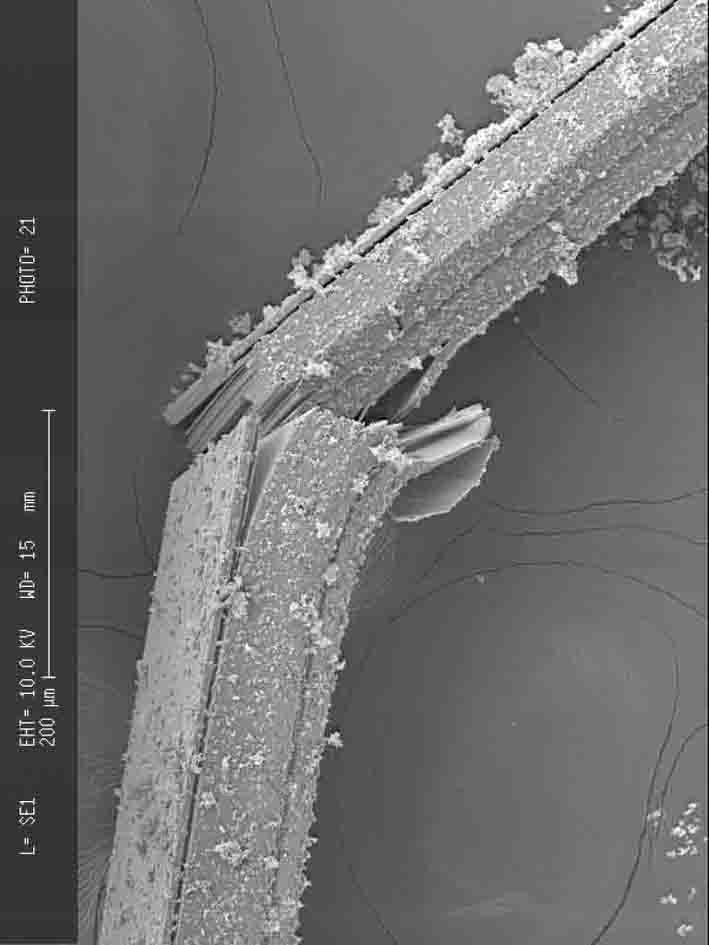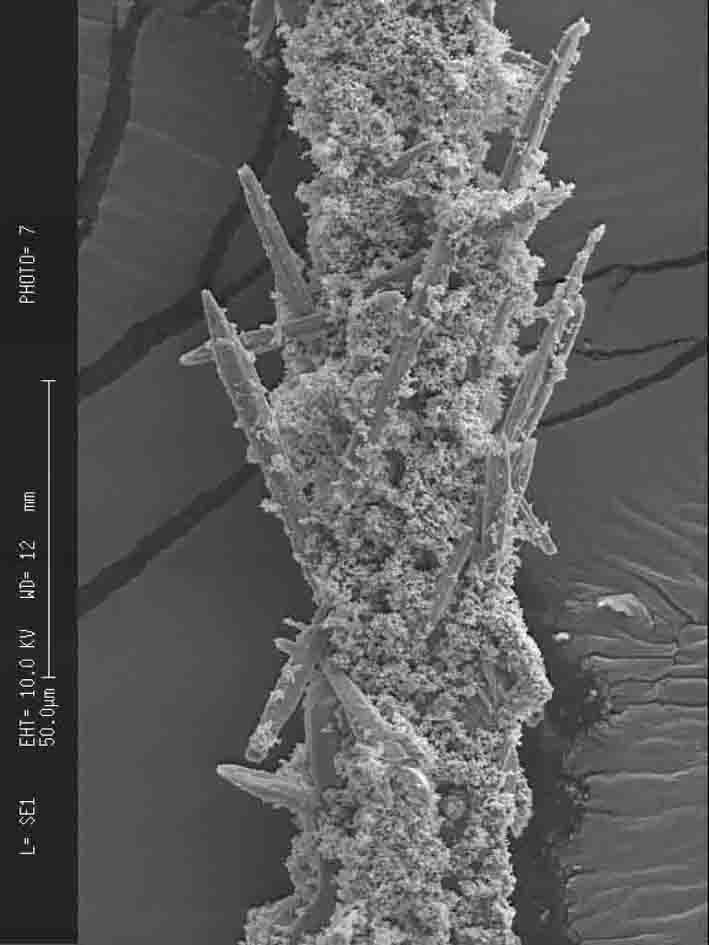Mineralogy and morphology of speleothems from Bulmer Cavern, North West Nelson, New Zealand
Introduction
Mineralogy and morphology of six speleothem types were investigated from the Soupmix 500 and Where The Wild Things Are areas, in the Lower Levels of Bulmer Cavern, North West Nelson. Bulmer Cavern is located within the Mt Owen karst massif of the Late Cambrian to Middle Ordovician Arthur Marble 1, which is part of the Mount Arthur Group (Rattenbury et al. 1998). Investigated speleothems included angel hair, cave wool, moonmilk, cave crusts, needles, and cave flowers. Analyses were done using XRD, XRF, SEM, and electron microprobe. XRD, XRF, and electron microprobe analyses showed that the angel hair, cave wool, cave crusts, and needles were composed of gypsum (CaSO4.2H2O); moonmilk of hydromagnesite (Mg4(CO3)4(OH)2.4H2O); and cave flowers of mirabilite (Na2SO4.10H20). SEM analyses enabled speleothem crystal structures to be investigated.
Angel hair
Angel hair is the name given to single stranded fibrous formations that hang from a cave wall or ceiling (Hill & Forti 1997). Examples in Bulmer Cavern are found in the Soupmix 500. The most prominent example grows in a cluster of five hairs, with the longest measuring 1050mm. The fibres are so fine that they waver in the breeze created by a caver moving past. In situ and fallen samples were collected from near the long angel hair site. Because of the minuscule sample that angel hair provides, mineral analyses were done using an electron microprobe, and an XRD with a cylindrical powder camera. Both analytical methods yielded good matches with gypsum standards.
SEM images showed the angel hair to be single prismatic monoclinic crystals with a perfect tabular cleavage (010), perpendicular to the b-axis, with elongation along the c-axis, conforming to a crystal form commonly assumed by gypsum (figure 1). A second type of angel hair appeared to have the single crystal core but had extensive secondary powder and crystal surface growths (figure 2). Single crystal angel hair measured between 57-109 μm, across the b-axis and 25-137 μm for the growth covered angel hair, although it was difficult to determine if measurements were across the a or b-axis. Secondary crystal growths consisted of acicular and euhedral crystals and fine powder that appeared to be single crystals or rosettes of micron-scale crystal aggregates.
A cluster of structures resembling "micro-helictites" measuring ~5 μm across were also seen on the surface of an angel hair. Secondary acicular crystal surface growths tend to radiate at chaotic orientations but tend to grow at ~30° from the angel hair surface.
 |  |  |
| Figure 1. An SEM image of gypsum angel hair showing a prismatic monoclinic habit and perfect tabular cleavage (scale bar 200 μm). | Figure 2. An SEM image showing an example of angel hair with extensive secondary surface growths (scale bar 50 μm). | Figure 3. An SEM image of hydromagnesite moonmilk showing the lath-like habit (scale 5 μm). |
Cave wool
Cave wool, cotton or beards are another type of fibrous speleothem resembling wool or fibrous fluff composed of masses of tiny inter-woven acicular or fibrous crystals (Hill & Forti 1997). Examples in Bulmer Cavern are found in Where The Wild Things Are and grow in lengths up to ~25cm, and in one case ~ 20cm wide, forming a beard-like structure. These examples resemble white candyfloss growing from the walls and sometimes have a growth texture resembling sheep's wool. Wool in this area seems to grow to a certain length, then breaks off under its own weight into piles on the floor, forming another formation sub-type known as snow (Hill & Forti 1997). XRD analyses showed good matches with the JCPDS x-ray standard for gypsum (record 21-0816). SEM imaging showed that the wool was made up of numerous, individual, randomly oriented, inter-fingered, acicular crystal, typically ranging between ~2-12 μm thick, but up to 25 μm thick. Crystal lengths were difficult to determine but were very long in relation to width, similar to the angel hair. Individual crystals appear to conform to the same prismatic, monoclinic form as the angel hair. Many of the individual wool crystals appear to end with natural crystal termination, which suggests that they do not grow continuously i.e. stop/start growth over time. This could be explained by the theory that fibrous formations are formed by a salting-out process from saturated water in bedrock pore space controlled by capillary forces, which is in turn controlled by seasonality (Hill & Forti 1997). Natural crystal terminations and stop/start growth could be explained if pore water becomes more or less saturated or if supply is greater or less seasonally.
Cave crusts
Crusts are speleothems that cover the roof, walls, or floor of a cave (Hill & Forti 1997). Examples in Bulmer Cavern are found in the Soupmix 500 and cover a floor area of ~10m2. Crusts are white, macrocrystalline and are spread on the floor in a chaotic manner, lying several layers deep in irregular sized and shaped flakes, averaging ~30x30cm across and between ~ 10-150mm thick, although there are many smaller or larger. A similar type of crust formation is present on the ceiling above the floor crusts suggesting that crusts have formed on the ceiling and have broken away. XRD analyses showed a composition of gypsum. SEM images showed that individual crystals were prismatic, monoclinic and showed the perfect tabular (010) cleavage perpendicular to the b-axis.
Selenite needles
Selenite needles are described as acicular twinned macroscopic crystals resembling knitting needles that grow in or on sediments (Hill & Forti 1997). Examples of needles in Bulmer Cavern are found in the Soupmix 500 and cover an area of ~1m2. They are clear to off-white acicular crystals that are typically 200-300 mm long and 2-3 mm thick, but up to ~600mm long and ~5mm thick. They appear in random orientations, like un-cooked spaghetti sticking out of dry unconsolidated sediment, as if they had been dropped like "pick-up-sticks", but sometimes radiate from a central point. Three needles were uprooted, revealing that they have a very short root in relation to their length and it appears that some needles grow to a certain length and fall over under their own weight. XRD analysis yielded a good match with the JCPDS standard for gypsum (record 21-0816), with some x-ray peaks corresponding to bassanite (CaSO4.½H2O) (record 41-1475). Selenite is a name commonly used to describe gypsum that is in a transparent, euhedral form (Deer et al. 1992). SEM and microscope investigation showed that needles are contact twinned in the (100) arrowhead/swallowtail form.
Cave flowers
Cave flowers are the name for fibrous, polycrystalline or prismatic crystals that radiate from a common point (Hill & Forti 1997). The cave flowers under investigation are found in the north end of the Soupmix 500 and grow from fractures in a partially sediment-buried 2 x 1.5 x 1.5m boulder. These examples appear clear and ice-like and grow to a maximum of ~150mm long and 25mm wide. It was quickly discovered that the cave flower crystals were unstable outside the cave environment. Temperature and humidity in the Soupmix 500 range between 4.2-5°C and 92-98% respectively. Samples had been refrigerated and kept in sealed specimen containers, but once removed crystals began to break down into a white powder. XRD and XRF results were ambiguous to begin with but this was thought to be because the mineral was changing form whilst being analysed. XRD analyses yielded results that were either mirabilite (Na2SO4.10H2O), thenardite (Na2SO4) or a mixture of the two. Given the cave's high relative humidity and that thenardite is the dehydration product of mirabilite, it was thought that the cave flowers are composed of mirabilite. A crushed sample heated overnight at 110°C in preparation for XRF analysis was found to have reduced in volume by around half by morning, also suggesting the mineral is quite hydrous. SEM investigation of cave flowers in their natural state was impossible due to their unstable nature and the lack of suitable equipment.
Moonmilk
Moonmilk is the name given to microcrystalline powder formations that are generally found on cave passage floors (Hill & Forti 1997). Moonmilk is found in several areas in Bulmer Cavern but the investigated moonmilk is found in Avalanche Alley within the Where The Wild Things Are area. This moonmilk blankets an area of ~50m2 of passage, from a thin covering to around 40 cm depth. The colour and consistency is very similar to that of cream cheese. XRD analyses showed a good match to the JCPDS standard for hydromagnesite (record 25-0513).
SEM investigation showed that individual moonmilk crystals appear as euhedral or subhedral tabular forms, between 1-5 μm but up to 25 μm across the long axis (figure 3). Murdoch (1954) reports that typical hydromagnesite crystals are monoclinic and lath-like, dominant along the (100) face. Based on this it was suggested that the prominent tabular faces seen in SEM images were perpendicular to the a-axis with the b and c-axis crystal dimensions very thin, too small to be seen (figure 3).
Conclusion
The six speleothems investigated are shown to have good mineral matches for either gypsum, mirabilite or hydromagnesite by using XRD, XRF, and/or electron microprobe. SEM and microscope investigation showed gypsum speleothems to be monoclinic, prismatic, sometimes twinned and either micro or macrocrystalline. The hydromagnesite moonmilk appeared tabular but is probably monoclinic with very thin b and c-axis crystal dimensions.
References
Deer, W. A., Howie, R. A. & Zussman, J. 1992. An Introduction to the Rock-Forming Minerals. Addison Wesley Longman Limited, Edinburgh gate, Harlow, Essex, CM20 2JE, England
Hill, C. & Forti, P. 1997. Cave Minerals of the World. National Speleological Society, Alabama.
Murdoch, J. 1954. Unit Cell of Hydromagnesite. The American Mineralogist 39 (1 & 2 ), 24-29.
Rattenbury, M.S., Cooper, R.A., and Johnston, M.R., 1998, Geology of the Nelson Area: Lower Hut, New Zealand, Institute of Geological and Nuclear Sciences Limited.